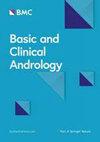Update on known and emergent viruses affecting human male genital tract and fertility
IF 2
3区 医学
Q2 ANDROLOGY
引用次数: 0
Abstract
Many viruses infect the male genital tract with harmful consequences at individual and population levels. In fact, viral infections may induce damage to different organs of the male genital tract (MGT), therefore compromising male fertility. The oxidative stress, induced during viral-mediated local and systemic inflammation, is responsible for testicular damage, compromising germinal and endocrine cell functions. A reduction in sperm count, motility, number of normal sperm and an increase in DNA fragmentation are all common findings in the course of viral infections that, however, generally regress after infection clearance. In some cases, however, viral shedding persists for a long time leading to unexpected sexual transmission, even after the disappearance of the viral load from the blood. The recent outbreak of Zika and Ebola Virus evidenced how the MGT could represent a reservoir of dangerous emergent viruses and how new modalities of surveillance of survivors are strongly needed to limit viral transmission among the general population. Here we reviewed the evidence concerning the presence of relevant viruses, including emergent and re-emergent, on the male genital tract, their route of entry, their adverse effects on male fertility and the pattern of viral shedding in the semen. We also described laboratory strategies to reduce the risk of horizontal or vertical cross-infection in serodiscordant couples undergoing assisted reproductive technologies.影响人类男性生殖道和生育能力的已知和新发病毒的最新情况
许多病毒都会感染男性生殖道,对个人和群体造成危害。事实上,病毒感染可能会对男性生殖道(MGT)的不同器官造成损害,从而影响男性的生育能力。在病毒介导的局部和全身炎症过程中诱发的氧化应激是造成睾丸损伤、损害生殖细胞和内分泌细胞功能的原因。精子数量减少、活力降低、正常精子数量减少以及 DNA 碎片增加都是病毒感染过程中常见的现象,但通常在感染清除后会有所缓解。但在某些情况下,即使血液中的病毒载量已经消失,病毒仍会长期存在,导致意外的性传播。最近爆发的寨卡病毒和埃博拉病毒表明,MGT 可能是一个危险的新病毒库,因此亟需新的幸存者监测模式来限制病毒在普通人群中的传播。在此,我们回顾了有关男性生殖道中存在的相关病毒(包括新出现和再次出现的病毒)、其进入途径、对男性生育能力的不利影响以及精液中病毒脱落模式的证据。我们还介绍了在接受辅助生殖技术的血清不一致夫妇中降低横向或纵向交叉感染风险的实验室策略。
本文章由计算机程序翻译,如有差异,请以英文原文为准。
求助全文
约1分钟内获得全文
求助全文
来源期刊

Basic and Clinical Andrology
Medicine-Urology
CiteScore
3.50
自引率
0.00%
发文量
21
审稿时长
22 weeks
期刊介绍:
Basic and Clinical Andrology is an open access journal in the domain of andrology covering all aspects of male reproductive and sexual health in both human and animal models. The journal aims to bring to light the various clinical advancements and research developments in andrology from the international community.
 求助内容:
求助内容: 应助结果提醒方式:
应助结果提醒方式:


